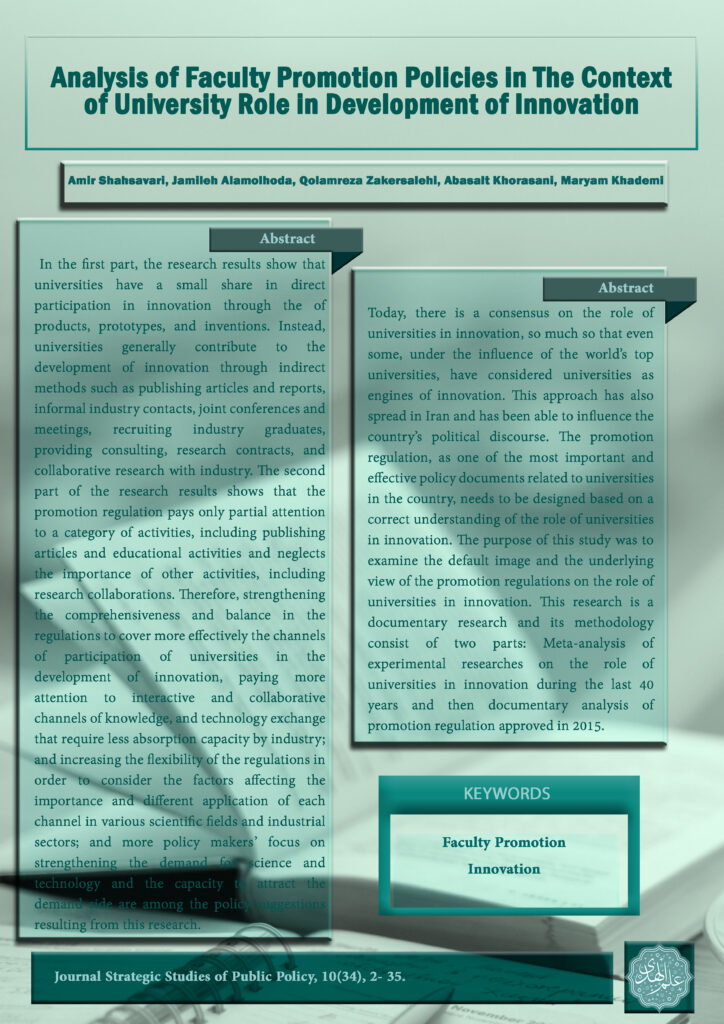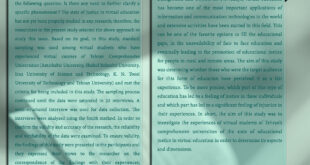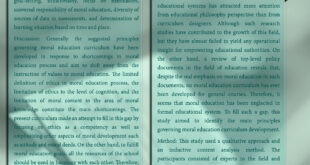Analysis of Faculty Promotion Policies in The Context of University
Role in Development of Innovation
1. PhD. Student, Department of Higher Education, Faculty of Education and Psychology, Shahid Beheshti University, Tehran, Iran.
2. Associate Professor, Department of Education Leadership and Development, Faculty of Education and Psychology, Shahid Beheshti University,
Tehran, Iran.
3. Associate Professor, Department of Comparative Studies and Innovation in Higher Education, Research and Planning Institute for Higher Education,
Tehran, Iran.
4. Associate Professor, Department of Higher Education, Faculty of Education and Psychology, Shahid Beheshti University, Tehran, Iran.
5. M.S. Department of Economics, Faculty of Economics and Politics, Shahid Beheshti University, Tehran, Iran
*Amir Shahsavari1 , Jamileh Alamolhoda2, Qolamreza Zakersalehi3, Abasalt Khorasani4, Maryam Khademi5
A B S T R A C T
Today, there is a consensus on the role of universities in innovation, so much so that even some,
under the influence of the world’s top universities, have considered universities as engines of
innovation. This approach has also spread in Iran and has been able to influence the country’s
political discourse. The promotion regulation, as one of the most important and effective policy
documents related to universities in the country, needs to be designed based on a correct understanding
of the role of universities in innovation. The purpose of this study was to examine
the default image and the underlying view of the promotion regulations on the role of universities
in innovation. This research is a documentary research and its methodology consist of two
parts: Meta-analysis of experimental researches on the role of universities in innovation during
the last 40 years and then documentary analysis of promotion regulation approved in 2015.
In the first part, the research results show that universities have a small share in direct participation
in innovation through the of products, prototypes, and inventions. Instead, universities
generally contribute to the development of innovation through indirect methods such as publishing
articles and reports, informal industry contacts, joint conferences and meetings, recruiting
industry graduates, providing consulting, research contracts, and collaborative research
with industry. The second part of the research results shows that the promotion regulation
pays only partial attention to a category of activities, including publishing articles and educational
activities and neglects the importance of other activities, including research collaborations.
Therefore, strengthening the comprehensiveness and balance in the regulations to cover
more effectively the channels of participation of universities in the development of innovation,
paying more attention to interactive and collaborative channels of knowledge, and technology
exchange that require less absorption capacity by industry; and increasing the flexibility of the
regulations in order to consider the factors affecting the importance and different application
of each channel in various scientific fields and industrial sectors; and more policy makers’ focus
on strengthening the demand for science and technology and the capacity to attract the demand
side are among the policy suggestions resulting from this research.

To download the full article file, click on the link below “Critical and Analytical Review of Master program”
 Dr Jamilesadat Alamolhoda Personal Website
Dr Jamilesadat Alamolhoda Personal Website


